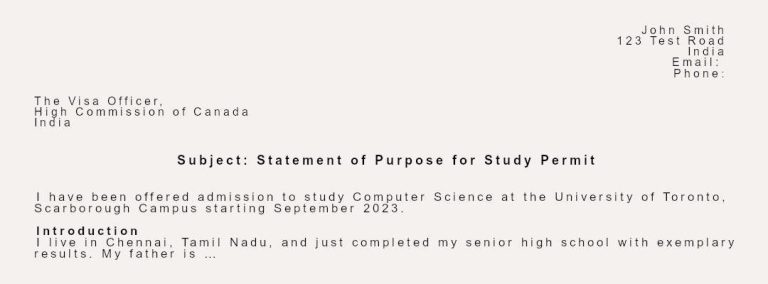The Statement of Purpose (SOP) for your study permit is a crucial document that supports your application for the permit. The SOP for an educational institution differs from the SOP for your study permit.
In this document, we will focus exclusively on the SOP for the study permit.
Guide Structure:
- Background
- Key Components
- Other Information – Length, Importance of Clarity Etc.
Background:

A Statement of Purpose (SOP) for your study permit is a written document that provides information about yourself and explains why you wish to pursue a specific program of study in Canada. It serves as a personal statement where you discuss your personal, educational, and career background, as well as your professional and personal goals and aspirations.
Moreover, it outlines your motivation for choosing Canada as your study destination. The SOP allows Canadian immigration authorities to assess your genuine intent to study in Canada and determine your eligibility for a study permit.
Importance of the SOP:
While your documentation, such as personal identification, educational qualifications, and professional records, provides factual information about you, the SOP helps the visa officer understand why you’ve chosen a particular program at a specific college or university in Canada. It also assesses whether you are aware of your responsibilities as an international student and your goals and ambitions in life.
In summary, your SOP for the study permit application should address the following:
- Who you are
- Why you want to study your chosen program in Canada
- How this program will benefit you academically and professionally in achieving your goals and aspirations
- Your financial capacity to support your studies and stay in Canada
- Assurance that you won’t be a burden on Canada in any way
Structure of an SOP/Key Components:
Introduction: In this section, briefly introduce yourself and explain why you have chosen to study in Canada and why the particular program at your chosen institution aligns with your life goals. Be concise, confident, and assertive.

Personal Information: Discuss yourself and your family briefly, emphasizing details relevant to your application. Highlight strong ties to your home country, such as obligations to care for aging parents and assets, to support your intention to return after completing your studies.
Academic Background: Detail your academic achievements in reverse order, starting with your latest qualification. Mention any awards, certifications, or other pertinent information that may strengthen your application. Include your English language proficiency qualification, such as IELTS. If there are any gaps in your academic resume, explain why it happened.
Professional Experience: List your professional experience in reverse order, including relevant details such as certifications, workplace achievements, and promotions. If you lack professional experience (e.g., applying right after high school), it’s acceptable. If there are any gaps in your career, explain.
Why Canada: Explain why you chose Canada over other countries, citing reasons such as program availability, the quality of education, the emphasis on theoretical over a theoretical-practical combination studies in your home country vs the importance of practical education in Canada, lower educational costs etc.
Why this Program: Describe why you selected your particular program, emphasizing how it aligns with your academic and professional qualifications and contributes to your career and personal goals. Highlight unique aspects of the program that will benefit you.
Why this Specific University/College: State why you chose your specific institution, mentioning factors like its reputation, academic standing, and placement opportunities that align with your academic and professional goals.
Professional/Career Objectives: Emphasize how your chosen program in Canada supports your career and professional goals, as well as your long-term aspirations. If your program includes co-op, internship, or research opportunities, explain how they will benefit your career.
Financial Resources: By now, you know the financial resources part has two components – the tuition and the living costs. Convince the visa officer that you have sufficient resources to cover both.
Travel History: Provide an outline of your previous travel experiences, if any.
Conclusion: Summarize your academic aspirations and how they align with your professional and personal goals. Conclude by thanking the visa officer for their consideration.
Additional Tips:
- Use word processing software, not handwriting, to create your SOP.
- Aim for an SOP length in the range of 1000-2000 words.
- Format your SOP with sufficient line spacing, appropriate margins, short paragraphs, and subheadings.
- Thoroughly proofread for grammatical and spelling errors. The SOP should be in clear and concise English or French. Remember that you will be studying in either English or French so you need to prove to the visa officer you have a good handle of the language. Therefore, proofread for grammatical, spelling, and other errors. Get your friends/family members and others to go through it.
- Emphasize your strong ties to your home country throughout your SOP.
- Treat this like a job interview where you have to show why you are the ideal candidate. In the case of SOP, show why you are so passionate about your program and why you think it will be benefit your future.
